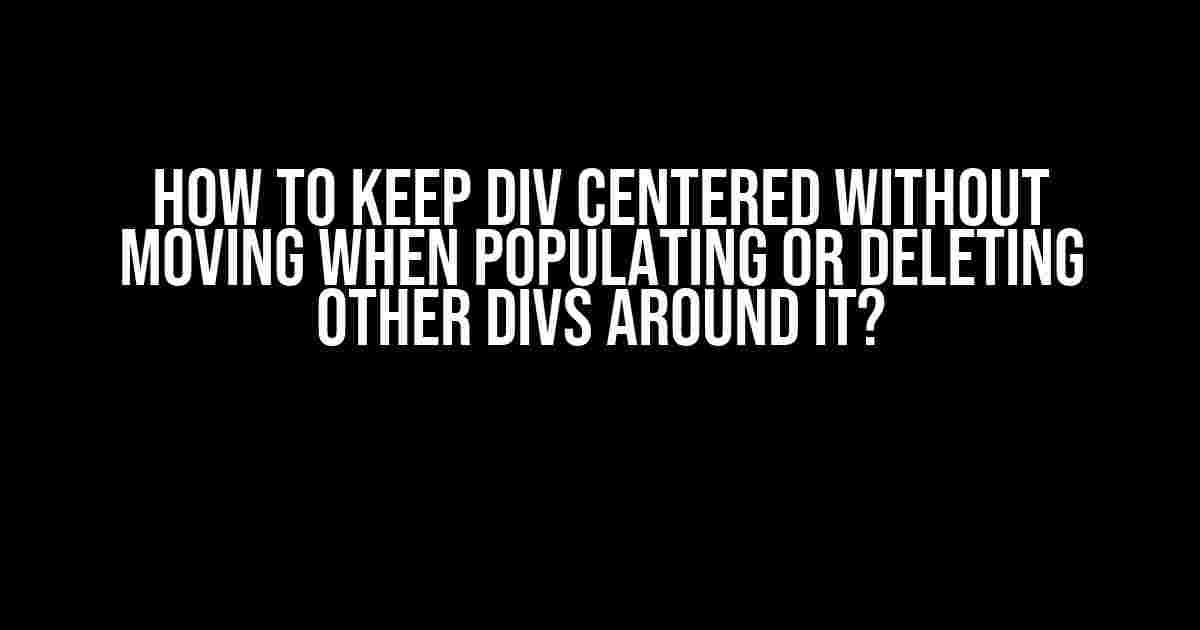Are you tired of dealing with pesky div alignment issues? Do you want to keep your div centered and stable, even when adding or removing other divs around it? Well, you’re in luck! In this article, we’ll dive into the world of CSS and explore the best practices for keeping your div centered, no matter what.
Understanding the Problem
Before we get started, let’s talk about why this is even a problem in the first place. When you add or remove divs around a centered div, it can shift its position, making it look wonky and unprofessional. This is because the div’s positioning is relative to its parent element, and when the parent element changes, the div’s position changes too.
Common Causes of Div Misalignment
- Adding or removing divs around the centered div
- Changing the width or height of the parent element
- Using absolute positioning without a fixed parent element
- Not setting a clear width and height for the centered div
Solution 1: Using Flexbox
One of the easiest ways to keep a div centered is to use flexbox. Flexbox is a CSS layout mode that makes it easy to align and distribute elements within a container. Here’s an example of how you can use flexbox to keep a div centered:
.centered-div {
display: flex;
justify-content: center;
align-items: center;
}
In this example, we set the display property to flex, and then use justify-content and align-items to center the div both horizontally and vertically.
Benefits of Using Flexbox
- Easy to implement and maintain
- Works well with responsive design
- Can be used for both horizontal and vertical centering
Solution 2: Using Grid
Another way to keep a div centered is to use CSS Grid. Grid is a two-dimensional layout system that allows you to create complex grid structures. Here’s an example of how you can use grid to keep a div centered:
.centered-div {
display: grid;
place-items: center;
}
In this example, we set the display property to grid, and then use place-items to center the div both horizontally and vertically.
Benefits of Using Grid
- Powerful and flexible layout system
- Can be used for both horizontal and vertical centering
- Works well with responsive design
Solution 3: Using Positioning
You can also use positioning to keep a div centered. Positioning allows you to specify the position of an element relative to its parent element or the viewport. Here’s an example of how you can use positioning to keep a div centered:
.centered-div {
position: absolute;
left: 50%;
top: 50%;
transform: translate(-50%, -50%);
}
In this example, we set the position property to absolute, and then use left and top to position the div 50% from the left and top edges of its parent element. We then use transform to move the div 50% to the left and top, effectively centering it.
Benefits of Using Positioning
- Works well with fixed-width elements
- Can be used for both horizontal and vertical centering
- Easy to implement and maintain
Solution 4: Using Margins and Padding
Another way to keep a div centered is to use margins and padding. By setting the margin and padding properties correctly, you can create a centered div. Here’s an example of how you can use margins and padding to keep a div centered:
.centered-div {
margin: 0 auto;
padding: 20px;
}
In this example, we set the margin property to 0 auto, which sets the left and right margins to 0 and the top and bottom margins to auto. We then set the padding property to 20px, which adds 20px of padding around the div.
Benefits of Using Margins and Padding
- Easy to implement and maintain
- Works well with responsive design
- Can be used for both horizontal and vertical centering
Best Practices for Keeping a Div Centered
Now that we’ve covered the different solutions for keeping a div centered, let’s talk about some best practices to keep in mind:
- Use a clear width and height for the centered div: This will help the div maintain its shape and position.
- Use a fixed parent element: This will help the div maintain its position relative to its parent element.
- Avoid using absolute positioning without a fixed parent element: This can cause the div to shift position when the parent element changes.
- Use responsive design principles: This will help the div adapt to different screen sizes and devices.
- Test and iterate: Make sure to test your div on different browsers and devices, and make adjustments as needed.
Conclusion
In conclusion, keeping a div centered without moving when populating or deleting other divs around it can be a challenge, but it’s definitely possible with the right techniques. By using flexbox, grid, positioning, or margins and padding, you can create a centered div that stays put, no matter what. Just remember to follow best practices, test and iterate, and you’ll be well on your way to creating a beautifully centered div.
| Solution | Benefits | Example Code |
|---|---|---|
| Flexbox | Easy to implement, works well with responsive design | display: flex; justify-content: center; align-items: center; |
| Grid | Powerful and flexible layout system, works well with responsive design | display: grid; place-items: center; |
| Positioning | Works well with fixed-width elements, easy to implement | position: absolute; left: 50%; top: 50%; transform: translate(-50%, -50%); |
| Margins and Padding | Easy to implement, works well with responsive design | margin: 0 auto; padding: 20px; |
By following these solutions and best practices, you’ll be able to create a beautifully centered div that stays put, no matter what. Happy coding!
Here is the HTML code with 5 Q&A about “How to keep Div centered without moving when populating or deleting other divs around it?”:
Frequently Asked Questions
Get answers to the most popular questions about keeping your divs centered and stable, even when surrounded by a sea of changing content!
How do I keep my div centered when I add or remove other divs around it?
To keep your div centered, use flexbox and set the parent container to `display: flex;` and `justify-content: center;`. This will ensure your div remains centered, even when the surrounding divs change. For example: `
`
What if I’m using a grid layout? Can I still keep my div centered?
Yes, you can! With a grid layout, use `grid-template-columns: 1fr;` and `justify-items: center;` on the parent container to keep your div centered. For example: `
`
How do I keep my div centered vertically as well as horizontally?
To center your div both vertically and horizontally, use `display: flex;` and `justify-content: center;` along with `align-items: center;` on the parent container. For example: `
`
What if I have multiple divs that need to be centered, can I use a class instead of inline styles?
Yes, you can! Create a class, such as `.centered-container`, and apply it to the parent container. Then, define the styles in your CSS: `.centered-container { display: flex; justify-content: center; align-items: center; }`. This way, you can easily reuse the centering styles across multiple elements.
Are there any browser compatibility issues I should be aware of when using these centering techniques?
While the techniques mentioned are widely supported, older browsers like Internet Explorer may require additional styles or polyfills. Always test your code in different browsers and consider using a CSS framework or library, like Bootstrap, to ensure cross-browser compatibility.
Let me know if you’d like me to make any changes!


